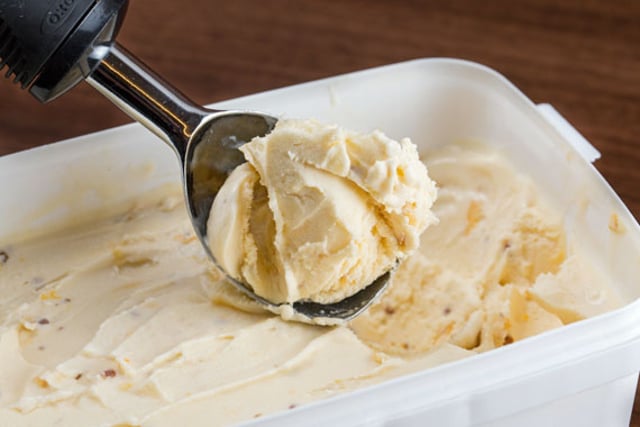This recipe produces the best ice cream I have ever tasted. Yes, really. The taste is exquisite and yet this is such an easy ice cream to make. It is a nice soft creamy easy-scoop ice cream.
As it's difficult to get hold of cloudberries the recipe uses cloudberry jam. If you don't live in Sweden you may need to order it online and, although it is an expensive jam, it is no dearer than a good bottle of wine. I promise you it's worth it!
Summary
Makes about 0.6 litres (1 pint)
Preparation: 10 minutes
Total: 10 minutes plus freezing time
Tips
– Keep the jam in the fridge until you need it. Good ice cream needs cold ingredients, apart from the egg and sugar, in order to freeze well.
– Use pure cane sugar if possible, as it is not possible to make a better ice cream with any other sugar.
– If you are short of time don't bother sieving the jam: just tip in unsieved jam in step 4.
Reminder
This recipe uses raw egg so the ice cream should not be served to anyone who shouldn't eat raw egg.

Cloudberries, or 'hjortron' as they are called in Swedish. Photo: Lise Åserud/NTB scanpix/TT
Ingredients
140g (5oz) cloudberry jam (about ½ cup)
1 large egg
90g (3oz) sugar, preferably raw cane sugar (about 3/8 cup)
240ml (1 cup) whipping cream (heavy cream)
120ml (½ cup) milk
Method
1. Sieve the jam into a bowl, but retain the seedy parts.
2. Whisk the egg in a mixing bowl until light and fluffy, about two minutes.
3. Whisk in the sugar, a little at a time, then continue whisking for another minute until well blended.
4. Pour in the cream, milk and sieved jam and whisk to blend.
5. Pour into an ice cream maker with the paddle running.
6. A few minutes before the ice cream is almost set, add the seedy parts and allow the seeds to be thoroughly mixed (see your ice cream maker's instruction book for advice on times).
8. Transfer to a tub and keep until required. Note: This ice cream is soft enough to serve straight from the freezer, but for best results move the tub to a fridge about 15 minutes before required.
Without an ice cream machine
If you have not got an ice cream machine, continue whipping after stage four for another two or three minutes, then transfer to an ice cream container. Cover the ice cream with clingfilm and freeze. Remove the mixture from the freezer every half hour. Fork over the mixture thoroughly and return to the freezer. Repeat this step until the mixture is thoroughly frozen, which will normally take two or three hours.
Recipe courtesy of John Duxbury, founder and editor of Swedish Food.



 Please whitelist us to continue reading.
Please whitelist us to continue reading.